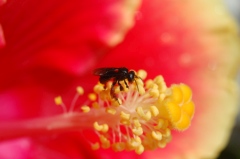Loading...
Loading...
A type of honey produced by stingless bees in Malaysia shows some protective effects against induced gastric ulcer in rats.
 |
| The Trigona species of stingless bee in Malaysia produces kelulut honey, which researchers found provided some protection against ulcers in rats. (Copyright: Ironman br via Wikimedia) |
Selangor, Malaysia, Aug 1, 2018 - (ACN Newswire) - Induced stomach ulcer (gastric ulcer) was smaller and less invasive in rats that regularly consumed a type of honey produced by a stingless bee in Malaysia. The study, published in the Pertanika Journal of Science & Technology, indicates that kelulut honey could be further investigated for potential anti-ulcer properties.
The internal lining of the digestive tract can become susceptible to the development of ulcers when it is exposed to excessively acidic content. This can happen as a result of smoking, nutritional deficiencies, prolonged treatment with non-steroidal anti-inflammatory drugs, or infection with a common stomach bacterium called Helicobacter pylori.
Commonly used anti-ulcer treatments can cause side effects, so researchers at Universiti Putra Malaysia, led by Associate Professor Latifah Saiful Yazan, investigated whether the antioxidants in kelulut honey could provide protection against stomach ulcer development.
The team placed 18 rats into three different treatment groups. One group was reared normally as a control. One of the two test groups was fed one tablespoon of kelulut honey twice daily for 30 days. At the end of the month, both test groups were fed ethanol to induce stomach ulcers, and then euthanized 15 minutes later.
The researchers studied the rats' stomach linings with the naked eye and under a microscope. They found that, although ulcers developed in the stomach of both test groups, the ones in the rats that regularly consumed kelulut honey were smaller and less invasive.
"The anti-ulcer properties of kelulut honey are believed to be due to its high antioxidant properties," the researchers write in their study. However, further research would be required to determine if there are similar benefits for humans.
Kelulut honey is produced by a stingless bee from the Trigona species. It has an intense colour due to the presence of two types of natural antioxidants: carotenoids and flavonoids. It also has a high phenolic content, which is considered a reliable indicator of antioxidant activity. Antioxidants could help protect against the development of ulcers due to their role in tissue growth and repair, and by activating the immune system to fight against bacterial infection.
In Malaysia, kelulut honey is often consumed to help with coughs, colds, to accelerate healing of internal injuries, and to delay aging.
For more information about each research, please contact:
Associate Professor Dr. Latifah Saiful Yazan
Department of Biomedical Science
Faculty of Medicine and Health Sciences
Universiti Putra Malaysia
Email: latifahsy@upm.edu.my
About Pertanika Journal of Science & Technology (JST)
Pertanika Journal of Science & Technology (JST) is published by Universiti Putra Malaysia in English and is open to authors around the world regardless of nationality. Currently, it is published twice a year in January and July. Other Pertanika series include Pertanika Journal of Tropical Agricultural Science (JTAS), and Pertanika Journal of Social Sciences & Humanities (JSSH).
Pertanika Journal of Science & Technology aims to provide a forum for high quality research related to science and engineering research. Areas relevant to the scope of the journal include: bioinformatics, bioscience, biotechnology and bio-molecular sciences, chemistry, computer science, ecology, engineering, engineering design, environmental control and management, mathematics and statistics, medicine and health sciences, nanotechnology, physics, safety and emergency management, and related fields of study.
For more information about the journal, contact:
The Chief Executive Editor (UPM Journals)
Head, Journal Division, UPM Press
Office of the Deputy Vice Chancellor (R&I)
IDEA Tower 2, UPM-MDTC Technology Centre
Universiti Putra Malaysia
43400 Serdang, Selangor
Malaysia.
Phone: +603 8947 1622 | +6016 217 4050
Email: nayan@upm.my
Distributed for Pertanika Journal of Science & Technology by ResearchSEA.
Source: Pertanika Journal
Copyright 2018 ACN Newswire . All rights reserved.
Loading...
Loading...
© 2024 Benzinga.com. Benzinga does not provide investment advice. All rights reserved.
Benzinga simplifies the market for smarter investing
Trade confidently with insights and alerts from analyst ratings, free reports and breaking news that affects the stocks you care about.
Join Now: Free!
Already a member?Sign in